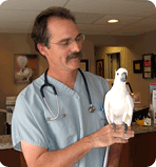Polyuria and polydypsia in parrots

I have an African Grey (3 years old) who I rescued in February of this year. He/She was kept in a plastic box with no toys and no available food. The family were feeding him on pizza, chips and salted nuts. He weighed so much he made your arm ache! He had escaped once from the family and rather than clipping his wings properly they had cut his flight feathers right back to the bottom of the feathers he was a terrible sight with drooped wings. He was extremely frightened of women but we spend a lot of time with him and he is coming round slowly. We now have him in a big cage, he has daily exercise (as he can now fly), plenty of toys etc. He is now a very different shape from the heavy ball he was when he arrived. We feed him on Harrisons which he doesn’t eat much of and various fruits (which he eats constantly) and nuts. We have always noticed ever since we have had him he drinks a lot and his droppings are always very runny but there is no blood etc. He is now a very happy bird and plays with men and talks a lot. We have noticed no change in his behaviour at all. We are worried his previous diet has had an effect on him internally.

It sounds like you have done some good things for this bird’s life.
The clinical signs you describe: Polyuria and polydypsia (increased urinary output and increased water consumption) can be potentially meaningful. When you had your veterinarian examine this bird and run some baseline laboratory values, what was seen? Some hepatic functional and/or renal functional disorders can be seen with these clinical signs, and they also can be seen sometimes for merely behavioral reasons. If diagnosed and treated appropriately in a reasonable timeframe, most conditions associated with causation of polyuria and polydypsea can be managed if not resolved, medically.
Your diet should be improved, however. With the still persistent diet containing primarily fruits (lots of simple sugars) and nuts, this bird is being bombarded with excessive energy in its diet, which can and will lead to a myriad of longer term medical problems, including but not limted to obesity, liver problems, cardiovascular disease, some kidney problems, etc. I would suggest that the diet be shifted to a predominately formulated base, with vegetable materials and limited fruits or seed as a general outline. Seed / nuts - if made available, should be used as environmental enrichments and positive reinforcers for additional behaivors, not simply dropped into the bird’s food bowl.

































